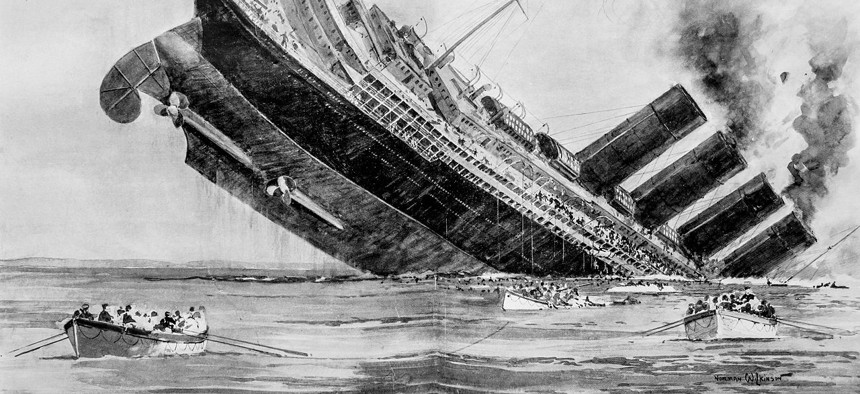
The 1915 sinking of the Lusitania backed President Woodrow Wilson into a corner. "Sinking of the Lusitania," an engraving by Norman Wilkinson in the Illustrated London News
What Presidents Do When Naval Encounters Turn Deadly
Three incidents that shook the nation hold lessons for future commanders-in-chief.
U.S. naval and air forces are engaged in a dangerous dance with their Russian and Chinese counterparts in the Baltic, Black, Barents, and South and East China Seas. What will happen if one of these aerial intercepts, fly-bys, or aggressive ship maneuvers should turn deadly?
It is worthwhile to look back at how previous U.S. presidents have reacted to such events. Under what circumstances have they been willing to escalate naval confrontations to the point of war, and when have they backed down? My new book looks at three naval incidents that shook the nation — the destruction of the USS Maine in 1898, the sinking of the Lusitania in 1915, and the aerial attack on the Panay in 1937 — and finds that these cases have lessons for the leaders of today and tomorrow.
First, presidents should anticipate that they will have to reach decisions well before all the facts are clearly established. In each case, the facts of the matter remained uncertain for weeks and even decades. The time lag between the Maine’s explosion and the presentation of findings by the Naval Court of Inquiry was more than three weeks, and later examinations called into question the initial findings. Even in the case of the Japanese air attack on the USS Panay, filmed and photographed by American journalists aboard the ship as it happened, uncertainty prevailed. Secretary of State Hull characterized Japanese claims that the incident had been a case of mistaken targeting as the “lamest of lame excuses,” but noted that absent firm proof implicating the Japanese government directly, the incident was no cause for war. Navy Secretary Claude Swanson felt otherwise. Presidential decision making takes place in an environment of uncertainty. More often than not, presidents must deal with disagreements among their advisors as they decide how to react and whether to escalate.
Related: Expect the Russians to Keep Buzzing American Navy Ships
Related: China Declares a No-Sail-Zone in Disputed Waters During Wargame
Secondly, these case studies make clear how difficult it is for presidents to back down from prior commitments and red lines once blood has been spilled. Secretary of State William Bryan, for example, cautioned President Wilson in early 1915 that he should avoid a showdown with Germany over the right of Americans to travel through war zones on British merchant and passenger ships transporting munitions. Once the Lusitania was sunk and 128 American citizens aboard the ship had perished, Wilson felt it impossible to back down from the principled position he had taken. Roosevelt likewise found it difficult to back down from his earlier commitments. As war clouds gathered in the Far East, FDR commented that he wished that the Marine detachment in Shanghai was not there. But as fighting escalated between the Japanese and the Chinese in 1937, he found it impossible to withdraw U.S. forces from the area; he felt any such move would be misinterpreted by the Japanese as a sign of weakness. As Secretary of the Interior Harold Ickes dryly remarked in his diary, “It is the old case of not doing something when it can be done and then when a crisis arises, deciding it can’t be done then.”
Lastly, one of the main points of the book is to expose how historical analogies and “lessons learned” can deceive as well as inform. By the earlier 1930s, much of the American public and foreign policy establishment had swung to the opinion that Wilson’s neutrality policies had been biased and unwise, characterized by a legalistic defense of principle and an unwillingness to compromise. Congress reacted to changing public opinion by passing a series of Neutrality Laws which backed away from defending rights at all costs, instead voluntarily restricting American activities in warzones. These “common sense” rules were well designed to avoid a repeat of the American slide to war between 1915 and 1917, but placed Roosevelt in a poor position when confronting Adolf Hitler. Context, opponents, and particularities matter.
As the United States faces two very different challenges in the East and West today, President Obama--— and whoever succeeds him — will need to think about what he or she will do if naval coercion fails, anticipate that cause and intent will be unclear after incidents have happened, and realize that interests, rights, and Realpolitik may pull in different directions.



